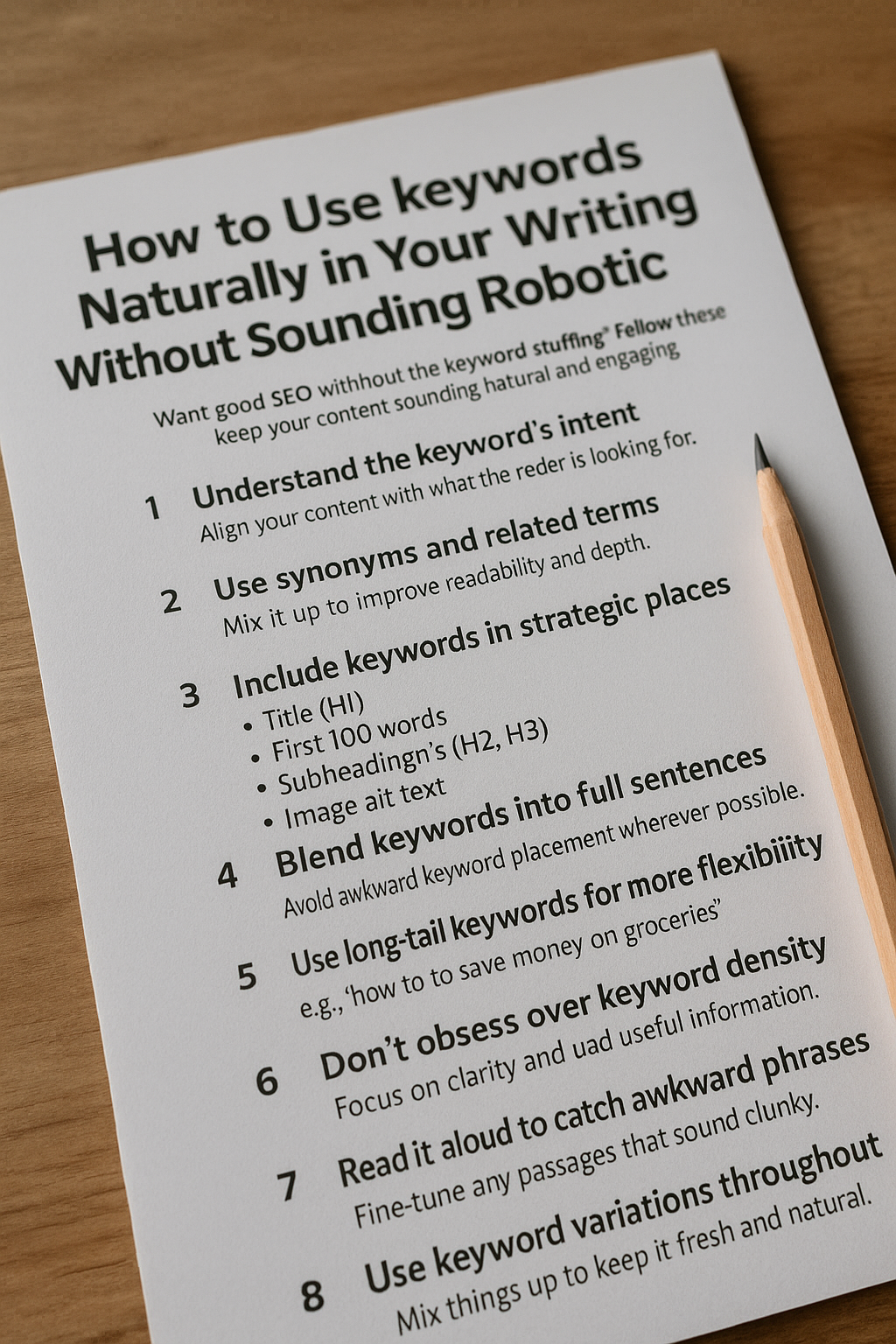If you’ve ever read an article stuffed with the same keyword over and over, you know how unnatural it feels. It’s awkward, distracting, and worst of all — ineffective.
But here’s the good news: you can write SEO-optimized content without sounding like a robot. When done right, keywords flow naturally and enhance both the user experience and search engine performance.
In this guide, you’ll learn exactly how to use keywords organically, so your writing remains clear, engaging, and Google-friendly.
Why Natural Keyword Use Matters
Search engines like Google are getting smarter. They no longer reward keyword stuffing — they prioritize relevance and readability.
Unnatural (and bad) example:
“This dog food for dogs is the best dog food for dogs who eat dog food.”
Yikes.
Natural (and good) example:
“Looking for the best dog food? Here’s what to consider when choosing a healthy option for your pet.”
See the difference? It still includes the keyword, but it sounds like something a human would say.
Step 1: Understand the Keyword’s Intent
Before placing a keyword, ask:
- What is the reader actually looking for?
- What problem are they trying to solve?
- What answers do they expect to find?
Example:
Keyword: “budget travel tips”
Intent: The user wants practical, affordable advice — not luxury recommendations.
Your content should match that expectation.
Step 2: Use Synonyms and Related Terms
Google recognizes related phrases and synonyms, so you don’t need to repeat the exact same keyword constantly.
Instead of repeating:
“Budget travel tips”
Try also using:
- “Affordable travel advice”
- “Cheap travel hacks”
- “Low-cost vacation strategies”
This improves flow and shows depth.
Step 3: Include Keywords in Strategic Places
There are key areas where keywords matter more:
1. Title (H1)
“10 Budget Travel Tips That Actually Work”
2. First 100 Words
Start strong and tell readers (and Google) what the article is about.
3. Subheadings (H2, H3)
H2: “How to Book Cheap Flights Like a Pro”
4. Meta Description
This shows up in search results, so make it count.
5. Image Alt Text
Always describe what’s in the image using relevant terms.
Step 4: Blend Keywords Into Full Sentences
Make the keyword part of a complete thought, not a forced insert.
Forced:
“You need budget travel tips. Budget travel tips help save money. Use budget travel tips now.”
Better:
“If you’re planning a vacation on a tight budget, these travel tips will help you save without sacrificing fun.”
Notice how the keyword fits naturally into the sentence.
Step 5: Use Long-Tail Keywords for More Flexibility
Long-tail keywords (3+ words) are easier to use organically and often less competitive.
Examples:
- “how to save money while traveling in Europe”
- “best travel backpacks under $100”
- “solo travel tips for introverts”
These fit into conversational writing more easily than short, generic terms.
Step 6: Don’t Obsess Over Keyword Density
There’s no magic number. Aim for clarity and usefulness, not a specific percentage.
A good rule: if it feels awkward or repeated, it probably is.
Step 7: Read It Aloud to Catch Awkward Phrases
When in doubt, read your paragraph out loud. If it sounds weird or repetitive, tweak it until it flows better.
Tip: Use tools like Grammarly or Hemingway Editor to catch clunky phrasing or overused words.
Step 8: Use Keyword Variations Throughout
Break up repetition by using plural forms, questions, or reordered versions.
Examples for the keyword “freelance writing jobs”:
- “jobs for freelance writers”
- “how to find freelance gigs”
- “remote writing opportunities”
This keeps your content engaging while still relevant.
Step 9: Focus on Value, Not Just Keywords
Keywords bring readers to your content. But quality, clarity, and usefulness are what make them stay.
Always prioritize:
- Answering questions clearly
- Providing examples
- Structuring content for readability
- Sounding like a real human
Final Thoughts: Write for People, Optimize for Search
You don’t need to choose between SEO and good writing. In fact, the best-performing content does both.
Use keywords thoughtfully, naturally, and strategically — and you’ll write articles that both rank and resonate.

It’s fascinating how mobile gaming taps into our reward systems! Convenience is huge – being able to quickly access games like through jkbose definitely adds to the appeal. A seamless experience is key, right? It’s all about that instant gratification!
sn5mzv